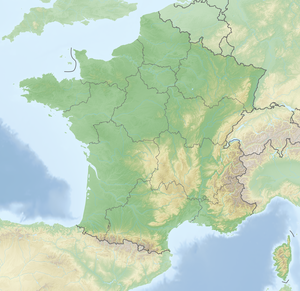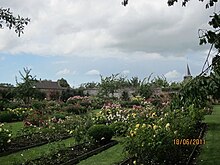Rambures Castle
| Rambures Castle | ||
|---|---|---|
|
Rambures Castle - Château Fort de Rambures (garden side) |
||
| Creation time : | 15th century | |
| Castle type : | Niederungsburg | |
| Conservation status: | completely preserved, never destroyed | |
| Standing position : | High nobility | |
| Construction: | Brick, plastered | |
| Place: | Rambures | |
| Geographical location | 49 ° 56 '39.8 " N , 1 ° 42' 26.6" E | |
| Height: | 25 m | |
|
|
||
The castle Rambures ( French Château de Rambures ) in the same locality is one of the rare well-preserved castles in the Middle Ages in France . It was built from brick in the 15th century and is considered a masterpiece of medieval defense architecture. It was besieged several times , but never taken. Its outer walls are still in their original state. The plant is since 23 February 1927 as a monument historique under monument protection and is the most visited castle in the Somme department .
location
The Niederungsburg is located in the municipality of the same name, Rambures, in the Somme department in the Picardy region, just a few kilometers south of Abbeville and a few kilometers north of the Bresle valley . It is located in northern France about 20 kilometers east of the coast of the English Channel .
history
The history of Rambures Castle and its owners is closely linked to the history of the Hundred Years War and the conquest of Picardy by the Duke of Burgundy . David de Rambures was with three of his sons in the Battle of Agincourt in 1415 and the death is as Lord Rambures even in Shakespeare's drama Henry V mentioned. The battle survived only André de Rambures (around 1395-1449), who continued to fight the English with the Dauphin , later Charles VII .
In 1423, three years after the Troyes Agreement , Philip the Good , Duke of Burgundy, conquered Rambures Castle with the help of the English. André de Rambures was captured in 1430 as captain of the castle there after the successful siege of Aumales by the Count of Suffolk. He was kept in captivity by the English for ten years and spent in England. During this time Charles Desmarets, a military commander of the King of France, recaptured Rambures Castle from the English and made it the base for further attacks on the English in Dieppe . André de Rambures was released from English captivity in 1440 for a ransom and continued to take part in the fight against the English.
The castle in its current form was built at the time of André de Rambures and his son Jacques, who was born in 1461 by Louis XI. was appointed spokesman for Charles the Bold . The completion of the complex is dated to 1470. In 1472 Jacques de Rambures submitted to the Burgundian Duke Charles, who stayed in Rambures for three months.
Owner and owner
The rule of Rambures was passed on through inheritance and marriage since the 11th century among the descendants of the de Rambures family. The list of Rambures owners is as follows:
- Seigneurs de Rambures
- Asson (11th century)
- David (until 1103), son of Asson
- Jean (12th century), son of David; married to Hawise de Bournonville
- Robinet, son of Jeans; married to Yde from the Melun family
- Jean, son of Robinets; married to Adeline
- Hugues (until after 1356), son of Jeans; married to Jeanne de Drucat
- Jean (until 1405), son of Hugues, governor of Arras ; married in second marriage to Jeanne de Berny, died in the attack on Château de Mercq
- André called Andrieux (until 1405), son of Jeans, Capitaine of Boulogne-sur-Mer and Gravelines , governor of the province of West Flanders; married to Jeanne de Bregny, died in the attack on Château de Mercq. There were at least three sons from this marriage: David his successor, Philippe et Florent.
- David de Rambures (1364 to 1415), son of Andrés, Grand Master of Crossbowmen since 1411; married to Catherine d'Auxy, began building the castle in its present form in 1412. His death in the Battle of Azincourt , along with three of his sons, interrupted the construction of the castle.
- André de Rambures (around 1395 to August 12, 1449), son of David; married to Péronne de Créquy, in 1429 he commanded a company near Orléans , where he met Jeanne d'Arc ; he died during the siege of Pont-Audemer .
- Jacques de Rambures (around 1428 to after 1488), son of Andrés; married to Marie Antoinette de Berghes Saint-Winoch, he finished the construction of the castle in 1470.
- André (until after 1512), Jacques' son, counselor and chamberlain to the King, Seneschal and Governor of Ponthieu since 1492 , Grand Master of Water and Forest in Picardy ; married to Jeanne de Halluin
- Jean (1500 to 1591); married Claude de Bourbon-Vendôme, dame de Ligny, in 1538, only a little later married in second marriage to Françoise d'Anjou, comtesse de Dammartin
- Charles (1572 to 1633), son of Jeans <, involved in the victory of Arques in 1589 , saved the life of his king, Henry IV , in the battle of Ivry in 1590, who dubbed him le brave Rambures ( German the brave Rambures ); married Renée de Boulainvilliers, dame de Courtenay in 1620.
- Marquis de Rambures in direct line
- Charles René (around 1622 to 1671), comte de Courtenay, son of Charles'; Marriage to Marie de Bautru in 1656.
- Louis Alexandre (1658 to 1676), son of Charles Renés, colonel d'infanterie, died at the age of 18 without offspring
- Charlotte de Rambures, aunt of Louis Alexandre and sister Charles Renés, inherited the property; with her marriage in 1645 to François de La Roche, marquis de Fontenilles, Rambures came to the Fontenilles family.
- Marquis de Rambures (La Roche Fontenilles family)
- François (until 1728), son; married Marie Thérèse de Mesmes in 1683
- Louis Antoine (1696 to 1755), son of François, Maréchal de Camp ; 1735 marriage to Elisabeth Marguerite de Saint-Georges de Vérac
- Antoine César (1746 to 1764), son of Louis Antoines, infantry officer
- Pierre Paul Louis (1755 to 1833), cousin of Antoine César and great-grandson of François and Charlotte, 1791 Maréchal de Camp ; Married Marie Claude Alexandrine Morard d'Arces, emigrated in 1791
- Adélaïde Honoré César (1786 to 1868), son of Pierre Pauls and Marie Claudes; 1833 marriage to Charlotte Antoinette Thérèse Le Clerc de Juigné
- Léon Alexandre (1835 to 1920), son of Adélaïde Honoré Césars and Charlotte Antoinette Thérèses; 1859 marriage to Marie-Thérèse de Chevigné
- Charles Antoine (1839 to 1930), brother Léon Alexandres; 1864 marriage to Louise Amour Marie de Bouillé. He and his wife were the last Marquis and the last Marquise of Rambures.
- Recent owner
- Guy Le Tellier, comte de Blanchard (until 1969), great-nephew Charles Antoines; inherited the castle in 1930
- Charles Henri Le Tellier de Blanchard de La Roche-Fontenilles, comte de Blanchard, son of Guys; married to Hélène Brosset. They have two children, Guillaume (1973) and Aurélia-Henriane (1976).
Architecture and park
The medieval castle has a square floor plan. Your masonry is made entirely of bricks. These were used in the 15th century as a modern building material in order to be better protected against artillery fire . In each corner of the square there is a round tower with a staircase .
A large park belongs to the castle , which is marked as a jardin remarquable . Noteworthy are the rose garden and a more than 200 year old sequoia tree , a souvenir from the American War of Independence of 1787.
literature
- Georges Conchon : Rambures . In: The most beautiful castles and palaces in France . Das Beste, Zürich / Stuttgart / Wien 1979, ISBN 3-7166-0020-2 , pp. 130-131.
- Philippe Seydoux: Le château de Rambures . Unknown June 1971.
- Philippe Seydoux: Le château de Rambures et la guerre au XVe siècle en Picardie . Editions de la Morande, [Roquetoire 1974].
Web links
- Castle website (French, English)
Individual evidence
- ↑ Entry no. PA00116225 in the Base Mérimée of the French Ministry of Culture (French)
- ^ Homepage of the castle , accessed on December 29, 2012.
- ^ Georges Conchon: Rambures . In: The most beautiful castles and palaces in France . Das Beste, Zurich / Stuttgart / Vienna 1979, ISBN 3-7166-0020-2 , p. 131.
- ↑ a b c Christine Debrie: Nicolas Blasset, architecte et sculpteur ordinaire du roi, 1600–1659 . Nouvelles Éditions Latines , Ort 1985, p. 276 ( online ).
- ↑ Parc et roseraie du château de Rambures (French), accessed December 9, 2012.



